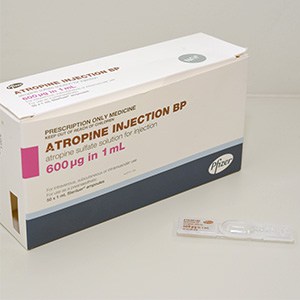Presentation
- 0.6mg/mL
- 1.2mg/mL
- 1mg/5mL pre-filled syringe
Role
- Initial treatment of bradycardia with associated haemodynamic compromise.
- Management of cholinergic toxicity caused by organophosphate poisoning. Aim for atropinisation, evidenced by:
- chest clear and no wheeze on auscultation
- heart rate greater than 80 beats per minute (note patients with toxicity often have paradoxical tachycardia on presentation)
- systolic blood pressure greater than 80 mm Hg.
Signs of anticholinergic toxicity occur with excessive atropine administration and include delirium, tachycardia, hyperthermia, urinary retention and ileus.

Consultation with a clinical toxicologist through local toxicology service or Poisons Information Centre 13 11 26 is advised with all symptomatic organophosphate poisonings.
Dose
Bradycardia due to poisoning
- 0.6 mg (child 20micrograms/kg) intravenously, repeat after 3 to 5 minutes if necessary, up to a maximum of 3 mg.
Organophosphate Poisoning
- Atropine 1.2 to 3 mg (child: 50micrograms /kg) IV as an initial bolus. After 5 minutes if no adequate response, double the initial dose. Continue to double the dose every 5 minutes until atropinisation achieved (see above). Doses up to 100 mg may be required.
- Following atropinisation, start an infusion at 20% of the total loading dose per hour.
Stocking recommendations
Atropine is readily available given it is a standard resuscitation drug.
Disclaimer
Fact sheet developed by Queensland Poisons Information Centre.
This fact sheet is about the use of these antidotes in Australia, and may not apply to other countries. Children’s Health Queensland Hospital and Health Service cannot be held responsible for the accuracy of information, omissions of information, or any actions that may be taken as a consequence of reading this fact sheet.